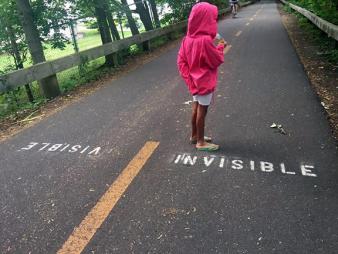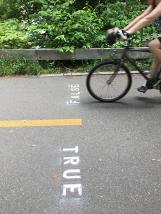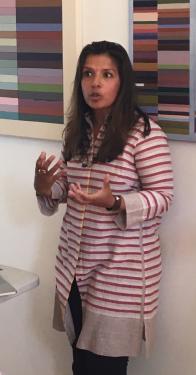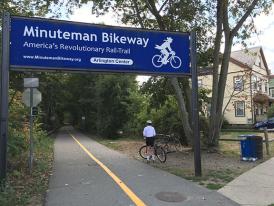Contribute
| Lokvani Talks To Nilou Moochhala |
Nirmala Garimella
09/12/2017
Q and A with Nilou Moochhala Share with us your professional background? My professional background is one of a designer as well as fine artist. For the past 17 years, I have been the creative director of an eclectic design studio, Nymdesign, founded in Brooklyn, NY, but now based in Boston, MA. The work we do encompasses branding and identity; print and book design; digital web and UX design, and also some dabbling in museum exhibition design. We are a collaborative space that includes designers, writers, UXers, and developers. We have been fortunate to work on projects that have allowed us to push the boundaries of visual experimentation and create thought-provoking narratives – each is a story waiting to be visually told. (Our varied clientele range from Amnesty International to Microsoft Corporation to Harvard/Yale Universities, among others.) My design journey has a past foundation in fine art as well – I was a painter and printmaker during my college years and worked in different institutions then such as the Smithsonian Institution in DC and Sotheby’s in NYC. During these years, I was very much drawn to social and political art that challenged norms, that incorporated community components, or that took place in public spaces –and yet were well-constructed, thoughtful, and appealing to look at. You could say that I have always been interested in how art or design can be used as a bridge to connect different cultures, communities, or neighborhoods, whether in these museums or city spaces. How can we use color, images, and words to communicate different messages and how does that meaning shift from one situation to the next? How did you come across this initiative in Arlington? The Minuteman Bikeway, a re-purposed old railway track turned paved bikeway which connects Cambridge to Bedford is turning 25 years old this year. On this anniversary, two town groups specifically in Arlington - called Arlington Public Art and Arlington Commission on Arts & Culture wanted to select a few artists to put up temporary public art installations on the part of the bikeway that runs through the Arlington section. They secured funding via cultural council grants and got approval from town officials to execute this idea. I was invited as one of the artists to participate in it. The project is officially called Pathways: Art Along the Minuteman Bikeway. My piece itself is called The Rhetoric of Opposites. What prompted you to participate? In response to the very volatile and divisive rhetoric taking place in the political spectrum earlier this year, I had participated in a local group show in called We, The People. The piece I created for that consisted of an old document/passport box belonging to my paternal grandmother in Mumbai/Bombay that was inlaid with double-sided black/white cards that had pairs of words on them such as Hope/Fear, Access/Denied, Visible/Invisible, Majority/Minority. These oppositional “identity†cards mirrored the exclusionary rhetoric and divisive language taking place in the country as a whole, which I felt was fueling resentment and fear – especially towards recent immigrant groups. As an immigrant myself (having left Bombay in 1990 to pursue my BA and then MFA degrees in the US), I was very much concerned and affected by what was happening in this country that is now my second home. Also, in my opinion, it must be the artists role in society to reflect back and catalog what is happening at a particular instance in time – to be a visual documentarian. This smaller gallery piece that I started with then grew into a larger installation on the Minuteman bikeway. How did you conceive of this project? As I mentioned above, the seedling of the idea for this project had germinated in response to the anti-immigrant and minority language occurring in the national political debate. When I started having a dialogue about the bikeway, it became obvious to me that the physical nature of the bikeway – where there are two lanes going in opposite directions right next to each other – was an obvious space to locate the pairs of oppositional words next to each other. They would sit alongside each other but face different directions (oriented towards the walker/biker). Also, the fact that the path is a travelling “in-between grey space†that connects two points – where you are to where you want to get to – also appealed to me. Like the solidly defined words that I wanted to put down in the bikeway, I also wanted the bikers/walkers to think about and understand the “grey areas†between these words when it comes to defining one another – whether in our community, city, or country. This particular bikeway has followed the historic path of those who rode from Boston to Concord and beyond during the American War of Independence, and therefore this installation seemed a perfect match for this space in order to discuss the current boundaries of freedom, tolerance, and state of the union. You used 25 opposite words on the Arlington bikeway. What was the thinking behind it? The section of the bikeway that has these 25 pairs of words is located between Linwood Circle and Arlington Center. It is a busy stretch of the bikeway – used for commuting during rush hours and also for recreation at other times. The pairs of words have been stenciled onto the actual path with temporary marking paint that will last 3-4 months. Each set of words is about 100 feet apart, so that you have a moment to read the first before the next one pops up (especially if you are moving faster on a bike rather than walking). The words were the part I struggled with the most – they are meant to make you “think†but not be so negative that you come away with no hope. By presenting this verbal language in a public space, I am hoping that the viewers themselves will take away what they want from the experience and interaction. What are your hobbies? Are you a bike enthusiast? As I mentioned, when I am not designing for a client, I am usually doing some sort of artistic experimentation through collage that deals with cross-culture identities and how we define ourselves. Recently, I have been spending a lot of time at the Museum of Fine Arts, looking through their modern and contemporary collections to get inspiration but also understand the challenges those artists/movements faced and how they visualized that in their work. Being part of a bi-racial family, it is important to me to investigate these connections and provide a framework for my daughter, who will grow up here and be defined differently in the next generation (from the way I am as an immigrant). In answer to your next question, I am a bike enthusiast: I grew up till I was 18 in Mumbai/Bombay, but lived on a road that had no through access, so we all learnt to ride a bike quite early in life. Although we lived on an inclined lane, so chances were we would be crashing into some sort of wall or tree at the bottom to stop ourselves! I do enjoy biking on the Minuteman bikeway, which is so convenient as it cuts right through Arlington parallel to Mass Ave, and am hoping to go with my young daughter more often in the future. Finally, what has been the response to this public art? This is a very interesting and relevant question, I am so glad you asked it! Firstly, the goal of this project was to create a popup art installation in a public space, and because of that, there is always the audience factor to contend with. I do have to say, that during installation, a lot of bikeway users came up to us and were so excited once we told them about the project. I would say that 95% of reaction to this piece has been positive. I do believe that those people who use the path every day and see those words start to derive different meanings from the install as the weeks go by. The other 5% that did not agree, was not from an art perspective, but more a public space perspective. For example, a biker came up to me during installation and said “I don’t want to think, I only want to bike. You are forcing me to think!†I really felt good when he said that, he was seeing it as negative feedback, but I took it as positive. The fact that I had actually made him come out of his commuting stupor and think about what those words mean, I think the piece was successful and had achieved its goal!
You may also access this article through our web-site http://www.lokvani.com/



